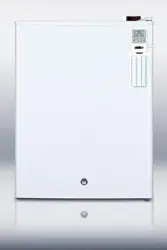Loading ...
Loading ...
Loading ...

Page 12
NOTES ON VACCINE STORAGE
[Recommendations are based on a report from CDC, the Centers for Disease Control and Prevention. For
more information, visit www.cdc.gov/vaccines]
Vaccines are fragile and they must be maintained at recommended temperatures from the time
they are manufactured until they are administered. This appliance is designed to keep your
vaccines at the proper constant temperature while they are stored inside.
Vaccine Storage Temperatures
Vaccines are sensitive and lose their potency if exposed to temperatures outside the required
temperatures (heat or cold).
Live Vaccines- These vaccines tolerate freezing temperatures but deteriorate rapidly
after removal from the freezer
All varicella-containing vaccines (VAR, Varivax; ZOS, Zostavax; and MMRV, ProQuad)
should be stored in a continuous frozen state, between -58 °F and +5 °F (-50°C and
-15°C).
Inactivated Vaccines - These vaccines are damaged by exposure to freezing
temperatures. However, they can tolerate short time out of refrigeration.
All inactivated vaccines require refrigerator storage temperatures between 35°F and 46°F (2°C
and 8°C), with a desired average temperature of 40°F (5°C). The following live attenuated
vaccines must also be kept at refrigerator temperature: influenza (LAIV, FluMist); rotavirus
(RV1, Rotarix and RV5, RotaTeq); typhoid (Ty21-A, Vivotif); and yellow fever (YF-Vax). Review
each manufacturer’s instructions in the product information for vaccine specific storage
temperatures. Aim for 40º F (+5 °C) to keep temperatures from getting too warm or cold.
The measles, mumps, rubella vaccine (MMR) can be stored either in the freezer or the
refrigerator.
Freezing of vaccine is considered to be the main reason for vaccine damage. Freezing is
where vaccines are exposed to temperatures at or below 0
o
C. Although the vaccines
may not visually appear solid or change in appearance if exposed to these temperatures
they are considered to be damaged. As such, visual inspection of vaccines must be
considered unreliable when assuring vaccine was stored under appropriate conditions.
Live attenuated vaccines and some inactivated vaccines must be protected from direct
sunlight or fluorescent light. The manufacturer’s product information indicates if the vaccine
must be protected from light.
Vaccine Storage Equipment
Vaccine storage equipment should be selected carefully, used properly, maintained regularly
(including professional servicing when needed), and monitored consistently to ensure the
recommended temperatures are maintained.
Loading ...
Loading ...
Loading ...
